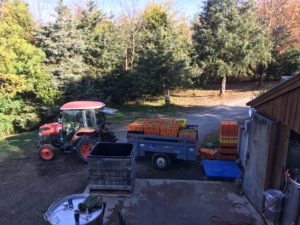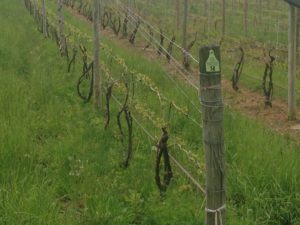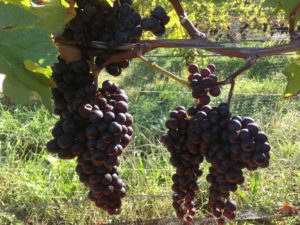2017 Harvest Report
by Shannon and Paul Brock, owner-winemakers
February 7, 2018–2017 will certainly go down in history as a “dark horse” vintage– emerging to prominence after seeming unlikely to succeed. After an unbelievably rainy spring and summer, a hot and sunny fall rescued the vintage. Our 2017 wines are exciting and lovely, with ripe flavors and vibrant acidity–a pleasant surprise after months of careful management leading up to harvest.
Early Season Promise
Let’s recap the year in detail. The winter of 2016-2017 was mild and uneventful. We didn’t even check for bud kill because temperatures almost never dipped below 0 degrees F. This ensured that 2017 had potential for a normal to large sized crop if managed properly with favorable weather.
Bud break occurred at the end of April which is a normal time-frame. Vines began blooming in mid-June and the fruit had set by early July. Weather was optimal during peak bloom and early fruit set which re-emphasized the potential large crop.
Monsoon Summer
The floodgates opened during the first three weeks of July, when more rain fell than during the entire growing season of 2016 (which was, admittedly, an extremely dry year). Because of the rain, vines grew more than normal, fungal disease pressure increased and young berries swelled to above-average size.
Through extra attention to detail and smart management, we reduced our crop size to maximize quality fruit development. We removed leaves from in front of the grape clusters for better sun exposure. We thinned fruit to reduce the number and size of clusters so vines could fully ripen the fruit they carried.
Silver Thread is committed to stewardship of our land and protection of Seneca Lake. In 2017, we continued our transition to bio-intensive management practices. Although rainy conditions made it extremely challenging, we used biological controls for vineyard diseases to the greatest extent possible while ensuring the quality of our crop. In reflection on this time we have learned a great deal to apply to our future management strategies.
The rainy conditions were ideal for continuing to establish our under-row cover crops. This practice eliminates the need for herbicides or cultivation. It improves our soil structure and microflora so that our vines are naturally more healthy and resistant to diseases.
Our challenges continued during August, with more rain and below-average temperatures during the last two weeks. Parts of New York State even had a frost in late August! A larger-than-normal crop with no warmth to ripen it? Things were not looking good.
Fairy Tale Ending
September dawned with rain and more cold temperatures. By the second week, things started looking up. We had three weeks of sunny days with temperatures in the 70s and 80s (even in the 90s for a few days). This weather literally saved the vintage; without it, the fruit was not close to being ripe.
Warm and dry weather continued into October, with several 80-degree days. We started harvesting in late September (a couple of weeks later than normal) but every variety achieved average to above-average ripeness. Harvest was extremely condensed due to the later start, with fruit being picked nearly every day in October.
While preparing to tame a potentially large crop throughout the growing season, we were able to bring our crop size to very close to our historical average with only a few varieties yielding ten percent more. This aided in achieving ripeness even though it took a bit longer than most years. The last two days of October signaled a hard end to this challenging growing season when we received 4 inches of rain followed by weeks of cold weather. By paying close attention to the forecasts we were able to bring in all of our fruit before the rain and November came.

The last of our estate Riesling was picked October 28, 2017, just before a storm brought 4 inches of rain.
Final Analysis
Bright acidity characterizes the wines of 2017 due to the cooler-than-average vintage and late ripening. The warm weather of September and October developed ripe flavors in the grapes. Disease pressure from rainy weather at the beginning of the season required some field sorting and crush pad sorting of Pinot Noir from Silver Thread and Riesling from one of our vineyards to ensure top quality. All other varieties were field-sorted (i.e. sorted while being hand-picked) to retain only optimal fruit.
2017 will be remembered as the year when it rained a lot at critical times—30% more total rainfall than an average Finger Lakes growing season. Through many extra hours in the vineyard, we were successful in limiting our crop and controlling disease for higher quality fruit, a difference we know you will taste in the wines.




